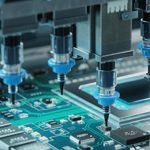The general understanding of capacitor types is helpful for rapid screening of capacitor types when selecting capacitors.
The general understanding of capacitor types is helpful for rapid screening of capacitor types when selecting capacitors. There are many kinds of capacitors, including chip capacitors and plug-in capacitors by package, ceramic capacitors, tantalum capacitors, electrolytic capacitors, mica capacitors, film capacitors, etc. by medium, and fixed capacitors, semi fixed capacitors, and variable capacitors by structure. There are many kinds of capacitors, which make people easy to suffer from the selection syndrome. But don’t worry. In switching power supply, we mostly use ceramic capacitors, electrolytic capacitors and tantalum capacitors. After knowing the types of capacitors, we will learn some performance parameters of capacitors.
The key parameters of all capacitors are the same, including capacitance value, withstand voltage value, ESR of capacitance, capacitance value accuracy, and allowable operating temperature range of capacitance. In the design of switching power supply, the capacitors with the highest frequency are ceramic capacitors, electrolytic capacitors and tantalum capacitors. It is necessary to understand their characteristic differences to make quick choices. Ceramic capacitors have small capacitance value, good high-frequency characteristics, wide operating temperature range, and ESR is smaller than electrolytic capacitors, small size, and no polarity; The capacitance value of electrolytic capacitor can be increased, but the operating temperature range is narrow, ESR is large, and it has polarity; Tantalum capacitor has the smallest ESR, and its capacitance is larger than that of ceramic capacitor. It has polarity, poor safety performance and is easy to catch fire.
The use environment of capacitor is also divided into the internal environment of the circuit and the external environment of the circuit. The internal environment of the circuit includes frequency, voltage value, current value, and the main role of capacitor in the circuit; The capacitance type can be determined according to the circuit frequency; The withstand voltage value of the selected capacitor can be determined according to the voltage value; The main function in the circuit can be used to refer to the capacitance value of the selected capacitor; Capacitors are selected according to the external use environment of the circuit. The ambient temperature and safety requirements of the product can be used to narrow the selection range of capacitors. Improper selection of capacitor will lead to slurry explosion, electrolyte drying and other phenomena in application, which will eventually lead to power failure.
The filter capacitor is used in the power supply rectifier circuit to filter out the AC components. Make the output DC smoother. And for precision circuits, the combination of parallel capacitor circuits is often used at this time to improve the working effect of filter capacitors. The low frequency filter capacitor is mainly used for the filtering of mains power or the filtering after transformer rectification, and its working frequency is 50 Hz consistent with that of mains power; The high-frequency filter capacitor is mainly used for filtering after switching power supply rectification, and its operating frequency is from several thousand Hz to tens of thousands Hz.
The filter capacitor plays a very important role in switching power supply. How to select the filter capacitor correctly, especially the output filter capacitor, is a problem that every engineer and technician is very concerned about. The common electrolytic capacitor used in 50 Hz power frequency circuit has a pulsating voltage frequency of only 100 Hz and a charge discharge time of millisecond order. In order to obtain smaller pulsation coefficient, the required capacitance is as high as hundreds of thousands of micro methods. Therefore, the goal of ordinary low-frequency aluminum electrolytic capacitors is mainly to improve the capacitance. The capacitance, loss tangent and leakage current of capacitors are the main parameters to identify their advantages and disadvantages.
The output filter electrolytic capacitor in switching power supply has a sawtooth voltage frequency of tens of thousands of Hz, even tens of megahertz. At this time, the capacitance is not the main indicator, and the standard to measure the high frequency aluminum electrolytic capacitance is the “impedance frequency” characteristic. It is required that the switching power supply should have a low equivalent impedance within the operating frequency, and have a good filtering effect on the high-frequency spike signals generated by semiconductor devices.
filter capacitorOrdinary low-frequency electrolytic capacitors begin to show inductance at about 10000 Hz, which cannot meet the requirements of switching power supply. The high-frequency aluminum electrolytic capacitor for switching power supply has four terminals. The two ends of the positive aluminum sheet are respectively led out as the positive pole of the capacitor, and the two ends of the negative aluminum sheet are also led out as the negative pole. The current flows in from one positive end of the four terminal capacitor, passes through the capacitor, and then flows to the load from the other positive end; The current returned from the load also flows from one negative end of the capacitor, and then from the other negative end to the negative end of the power supply.





